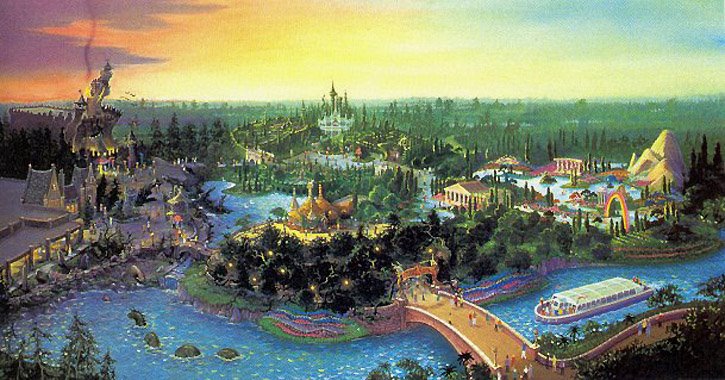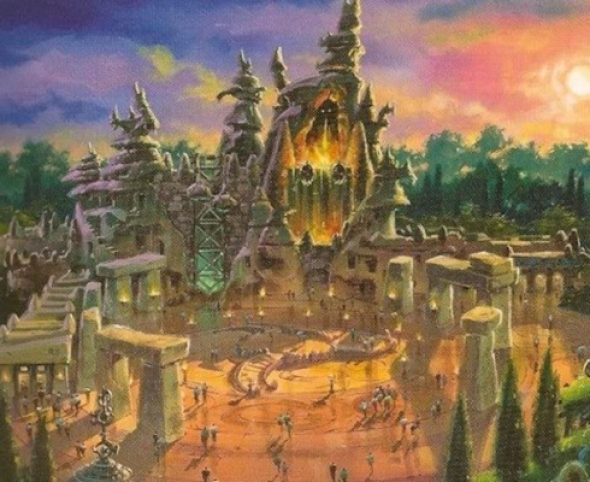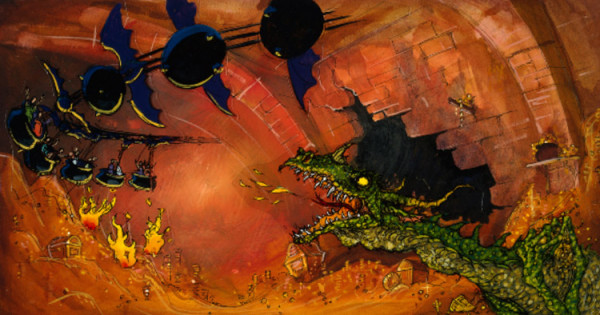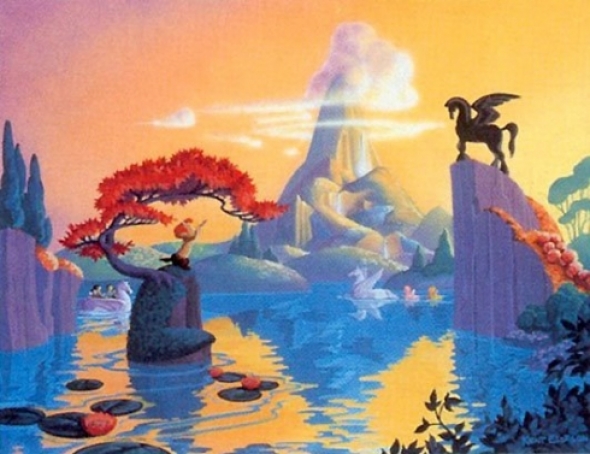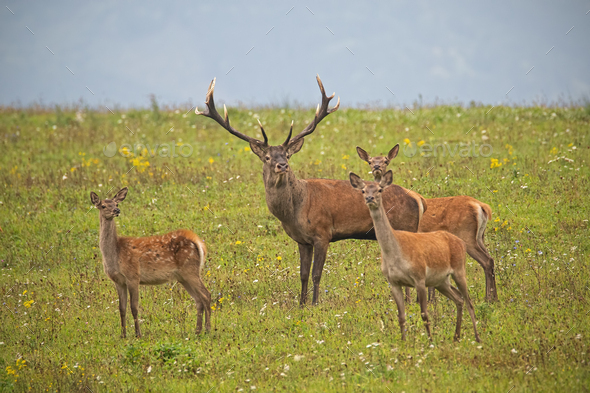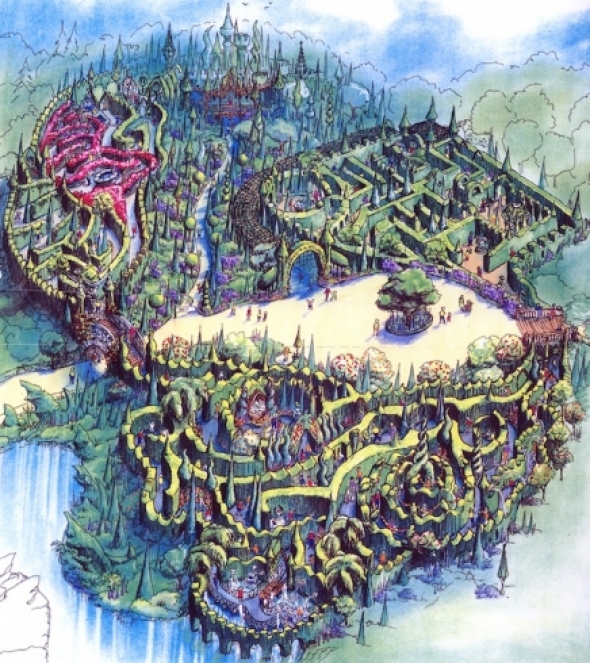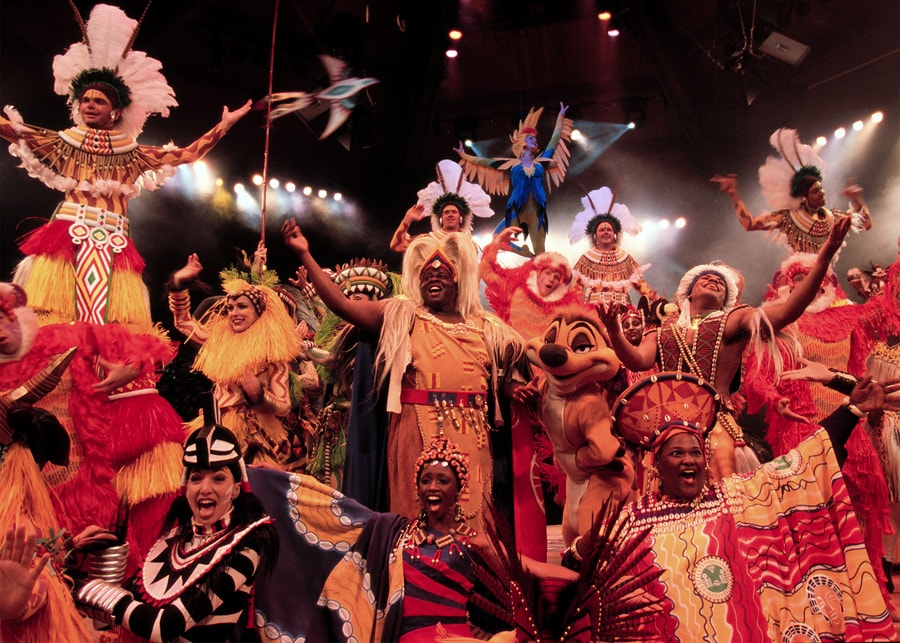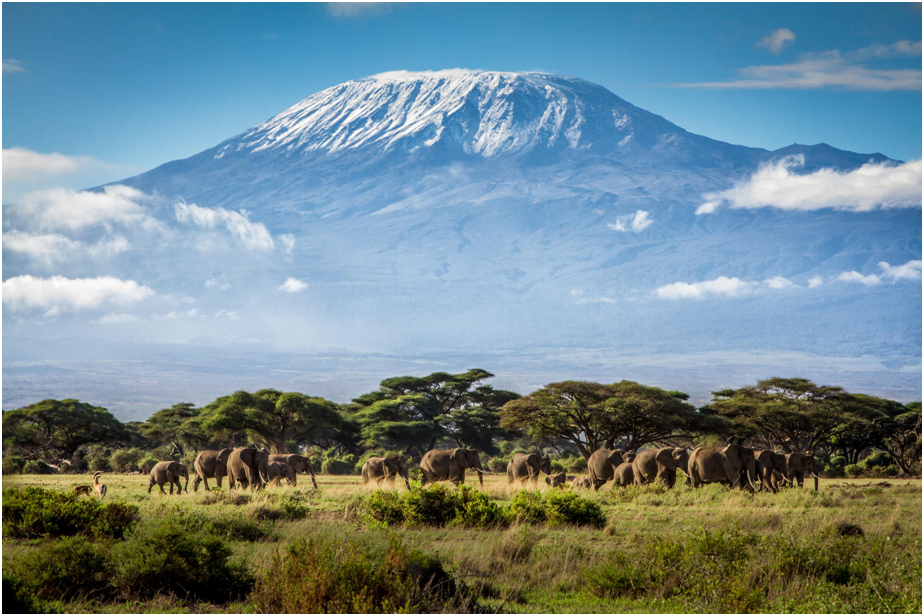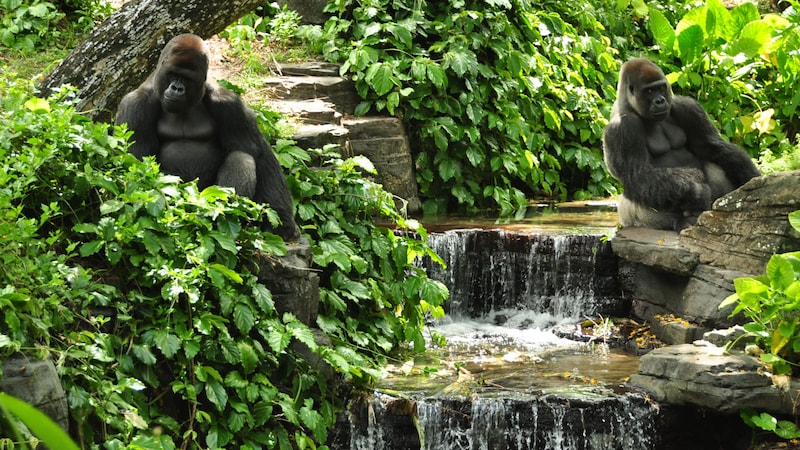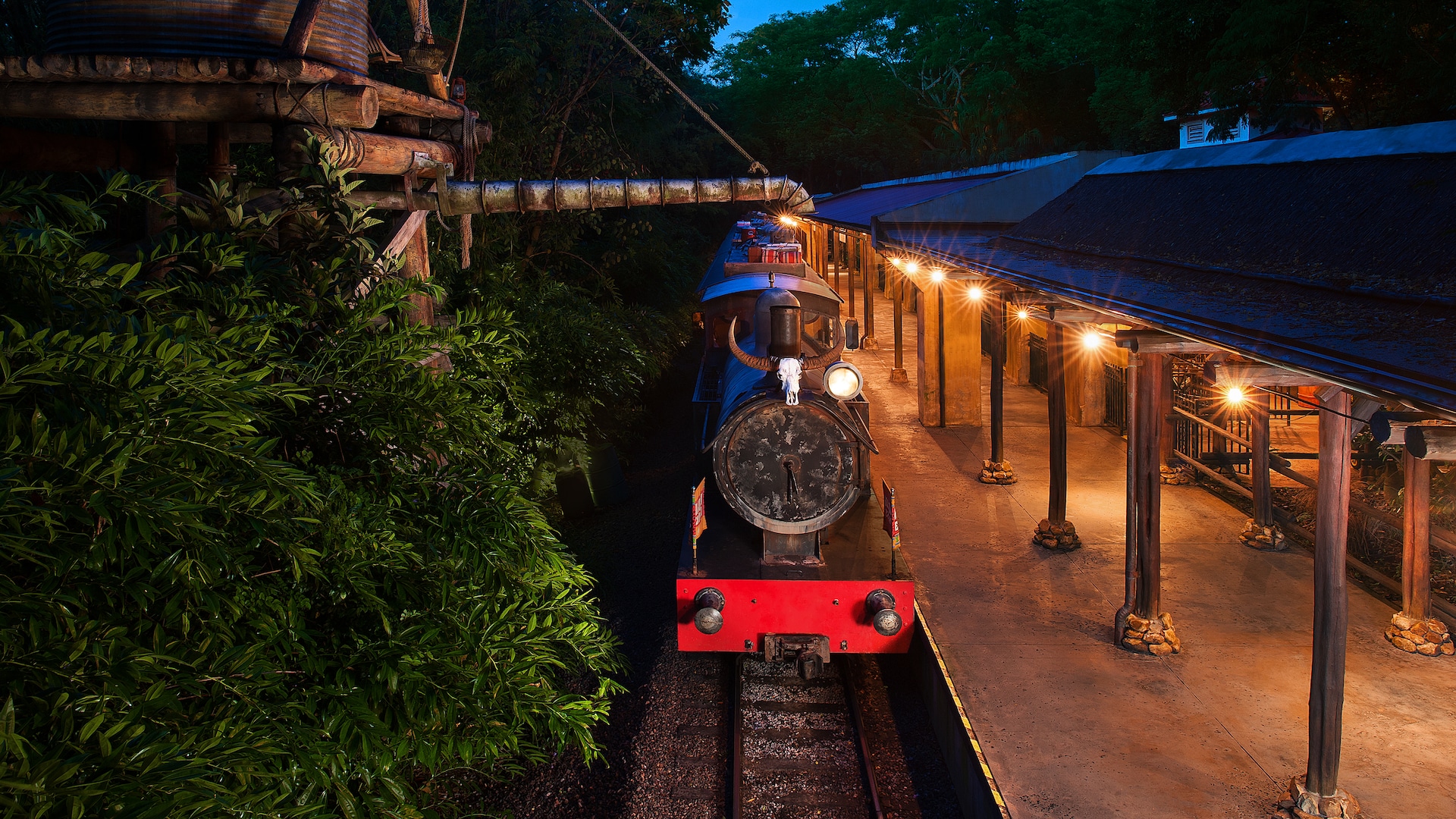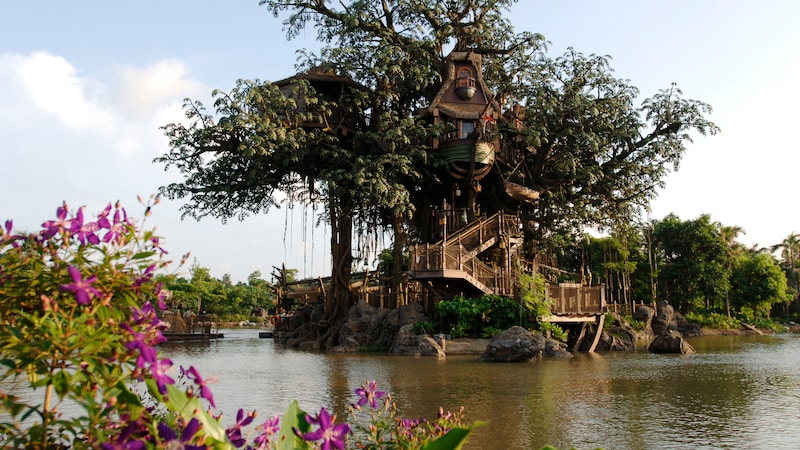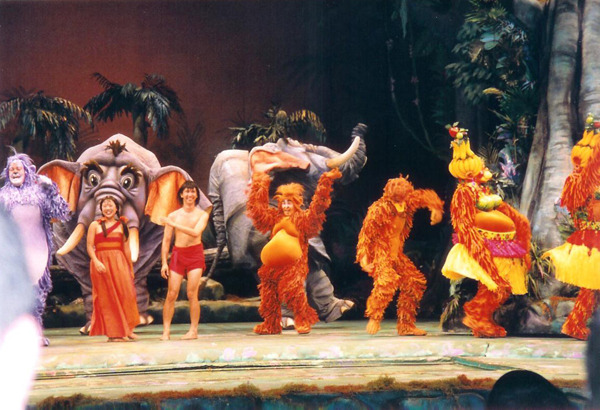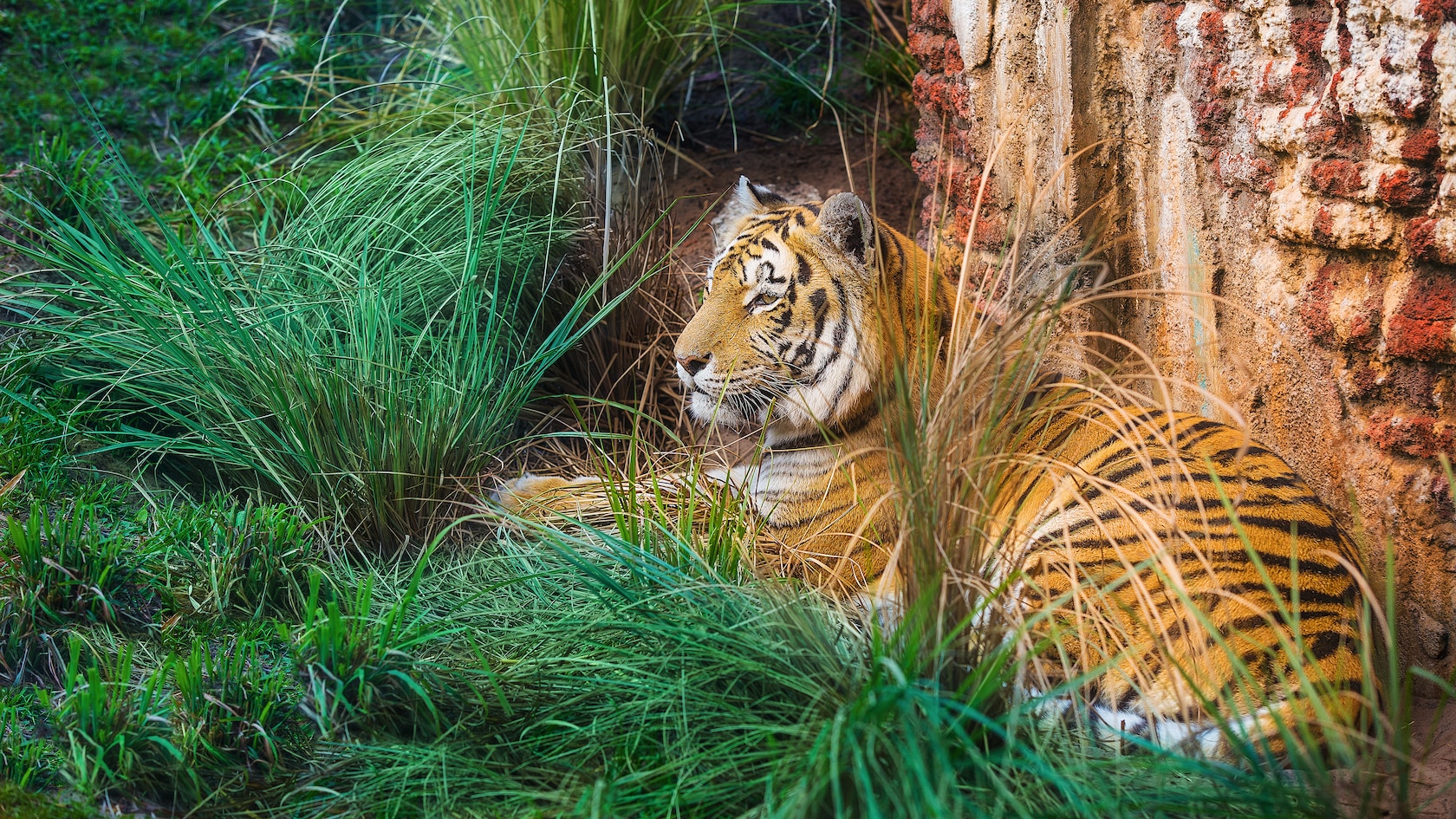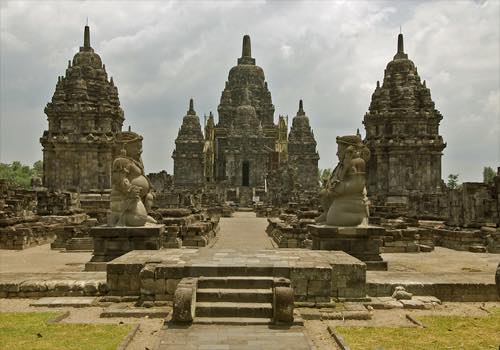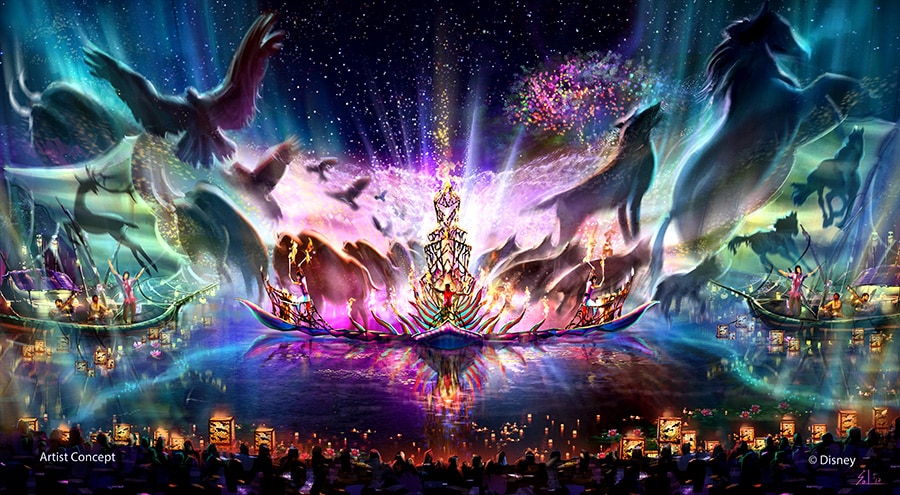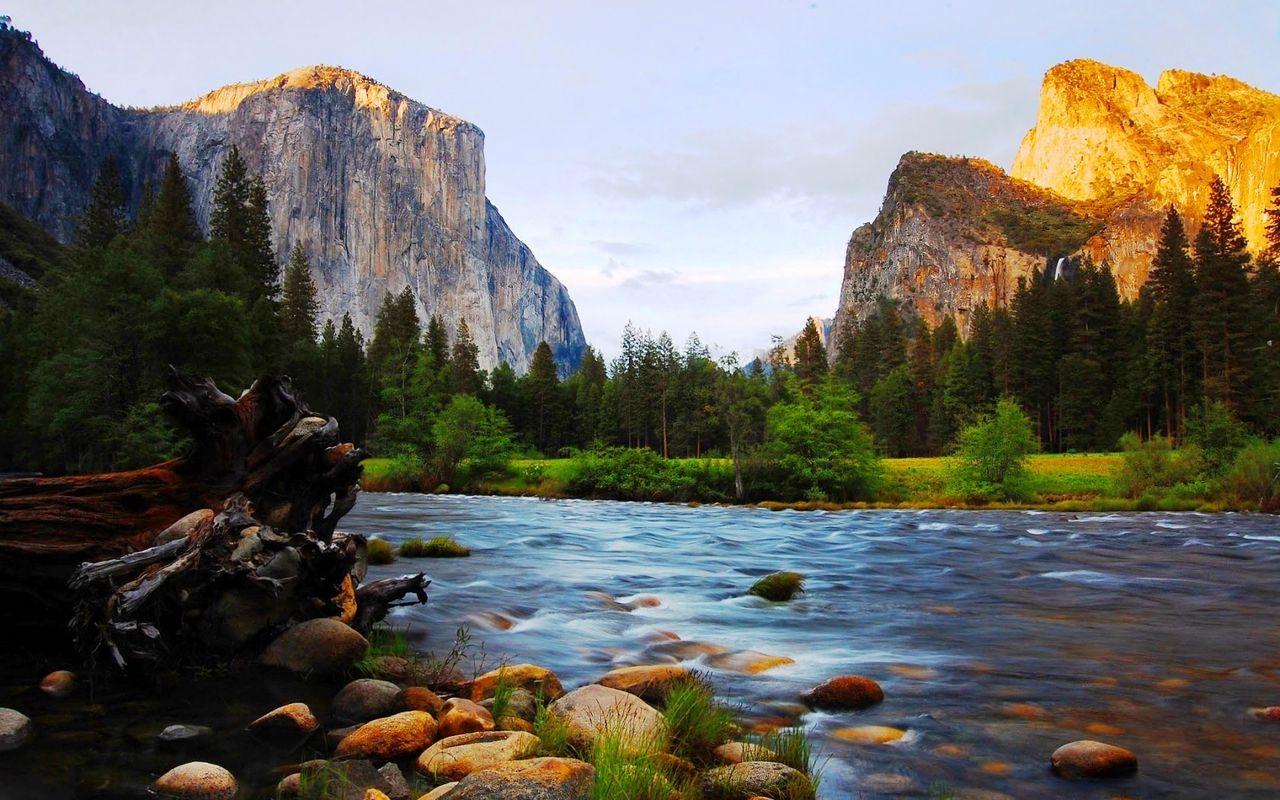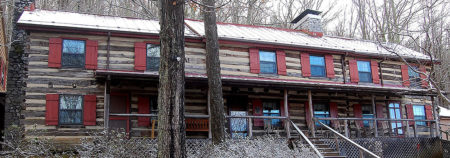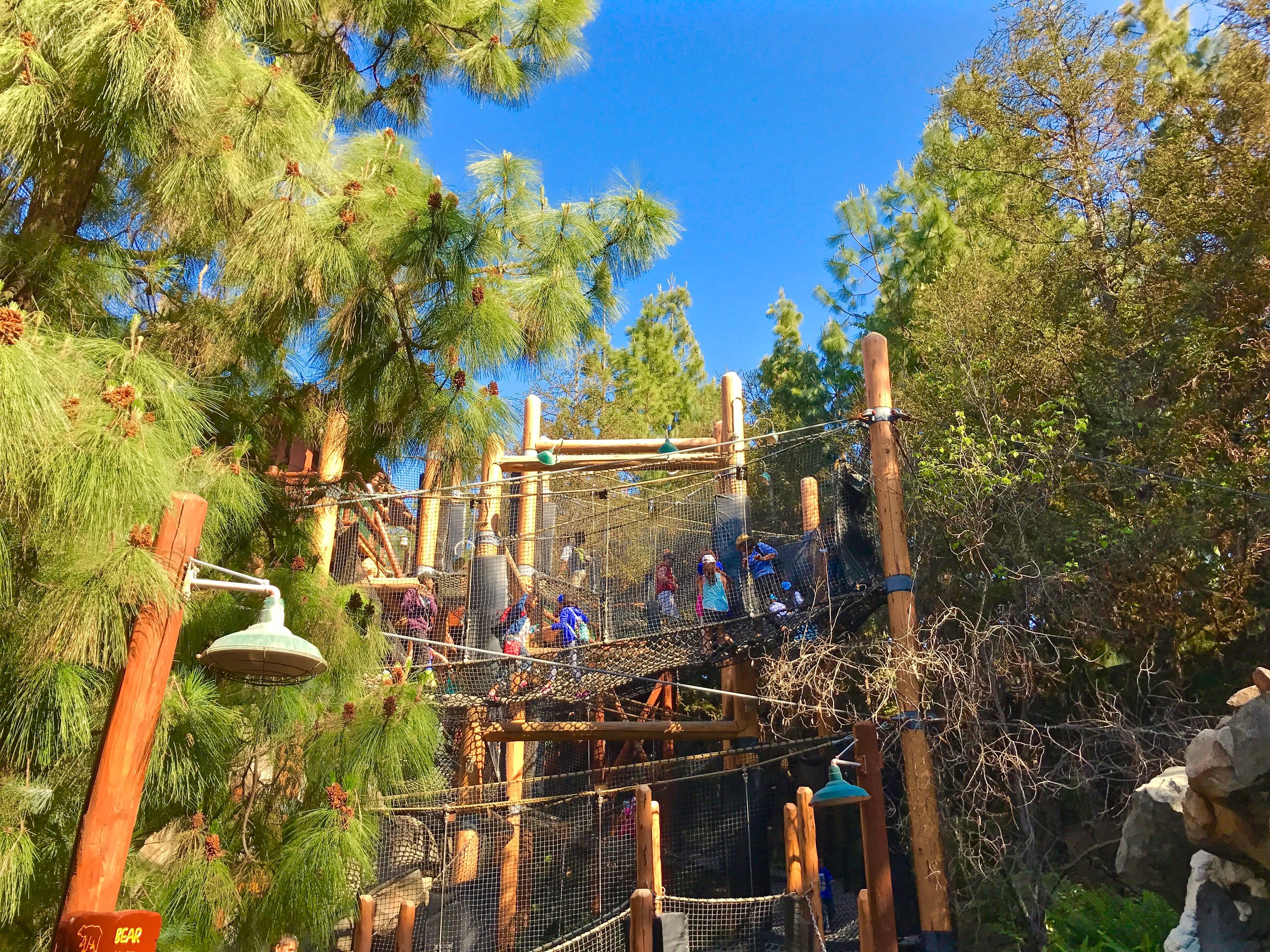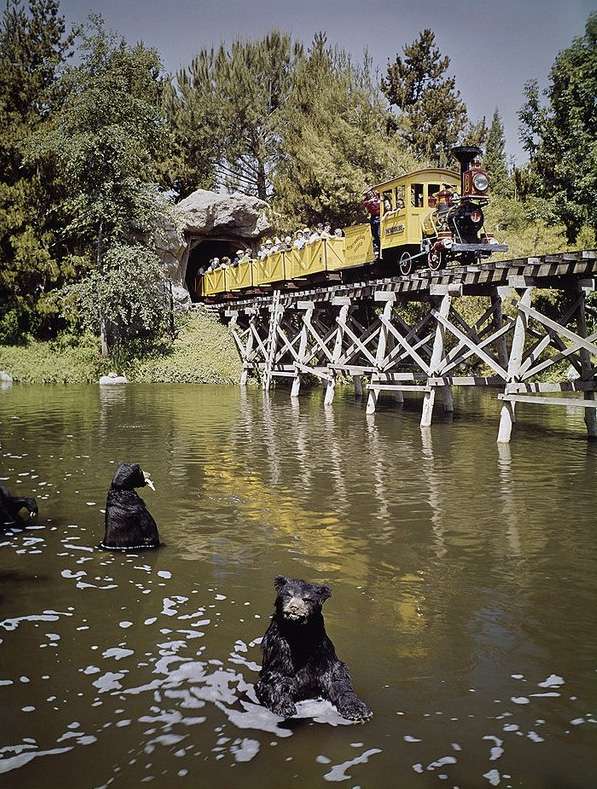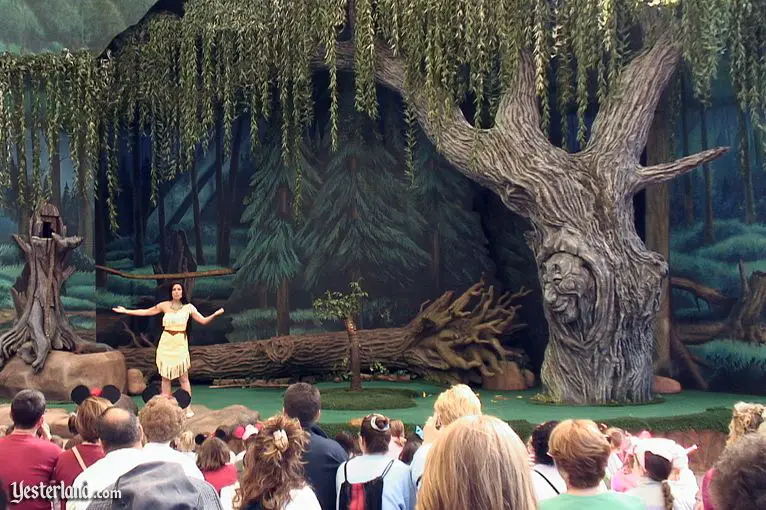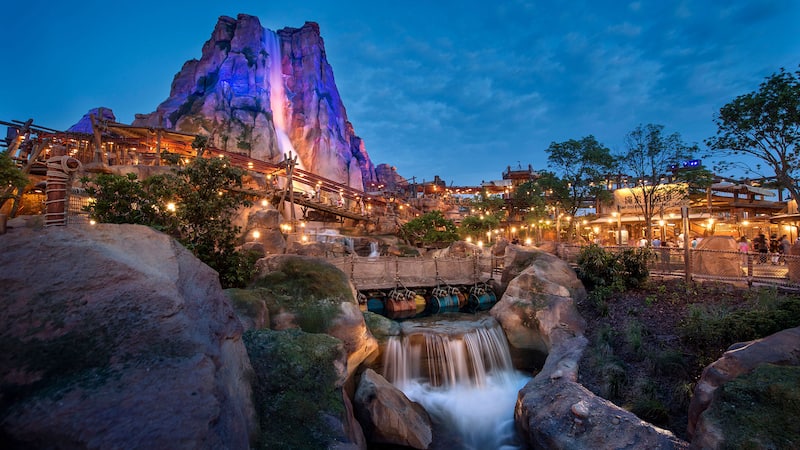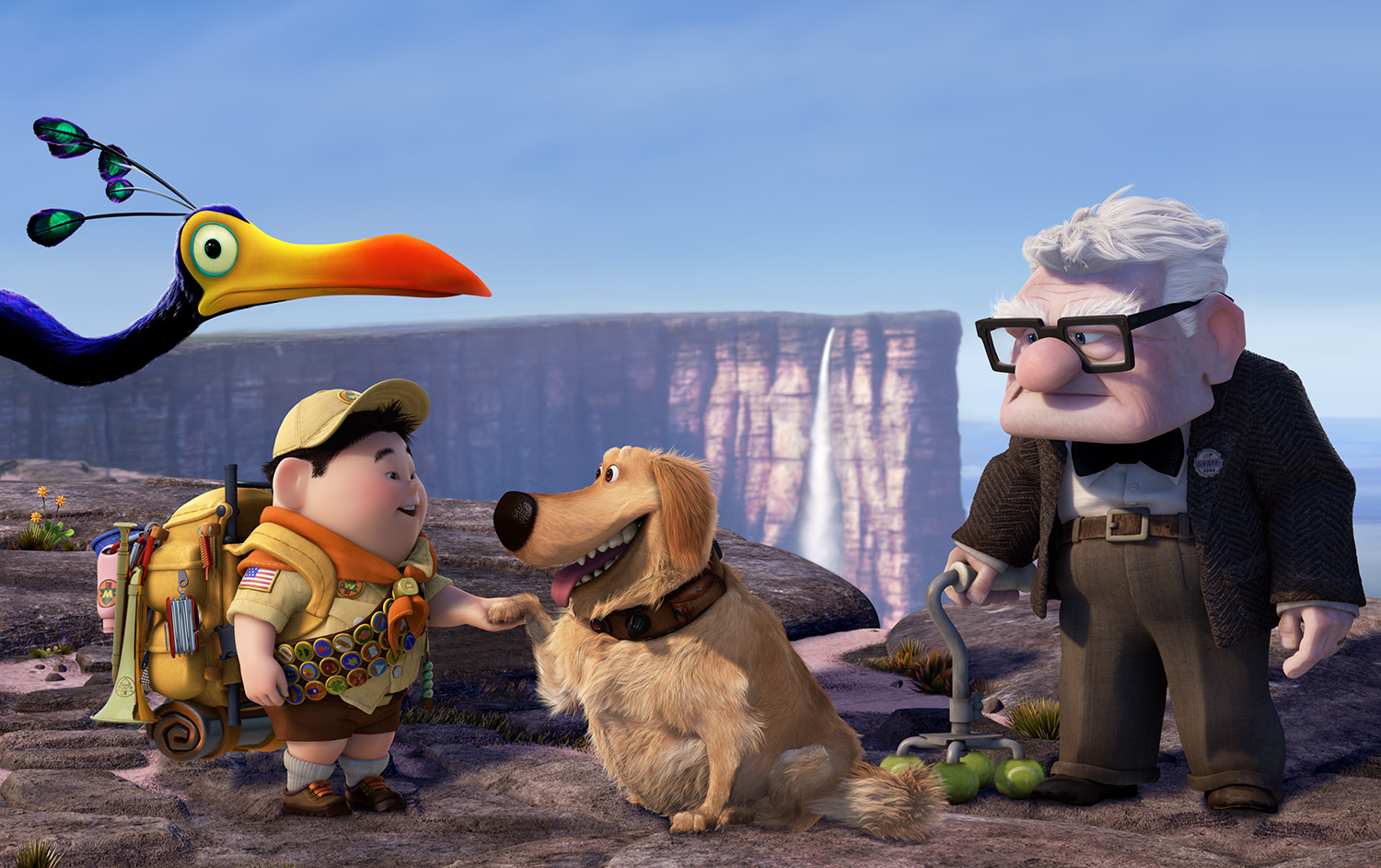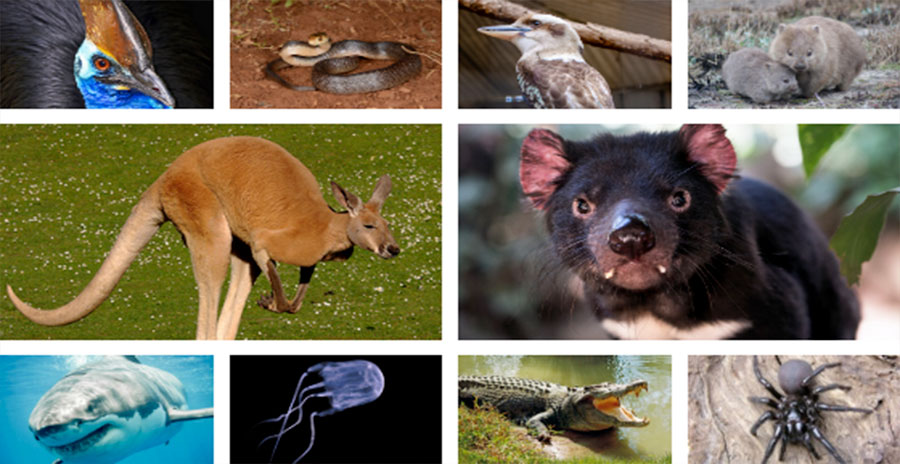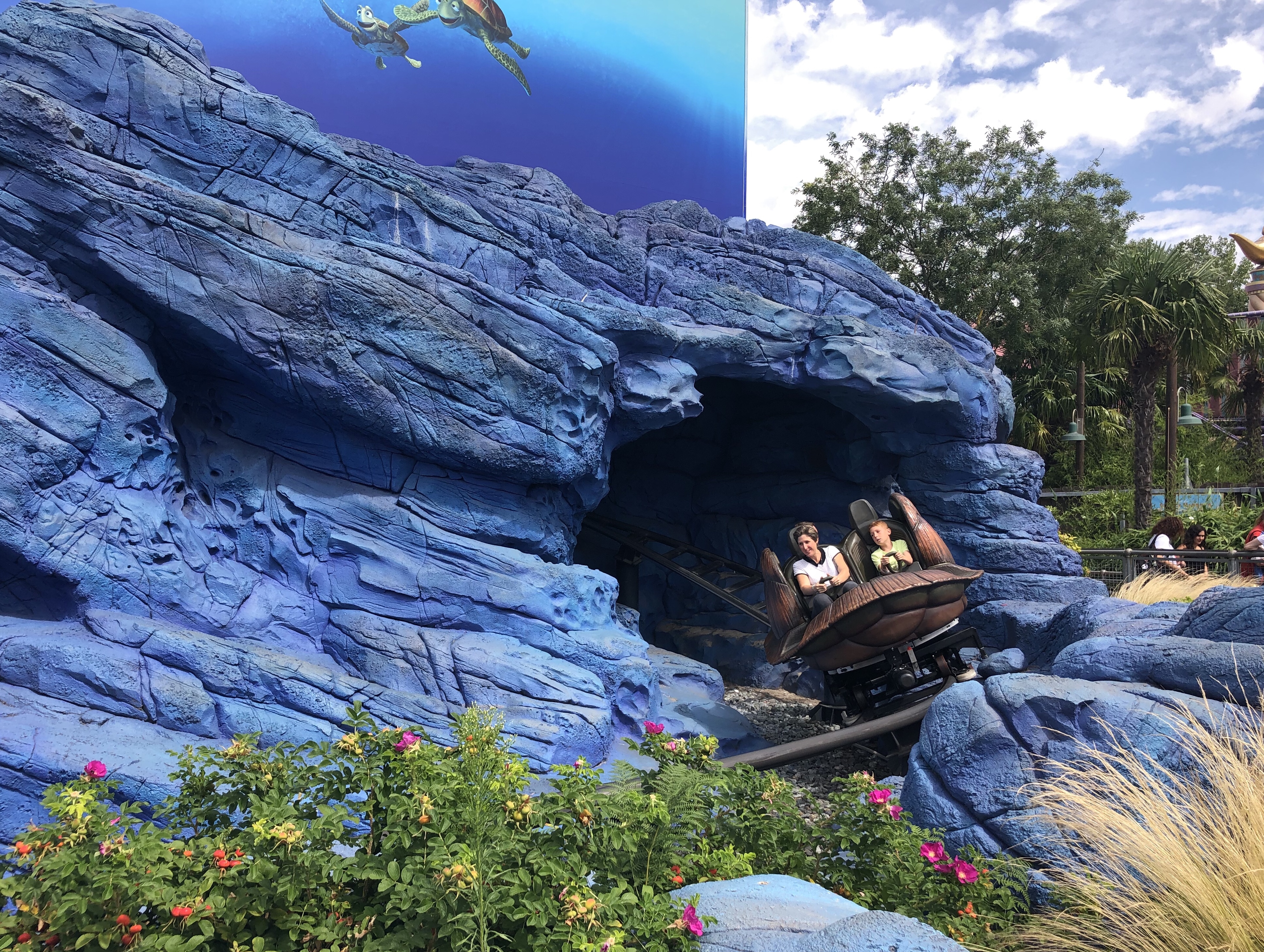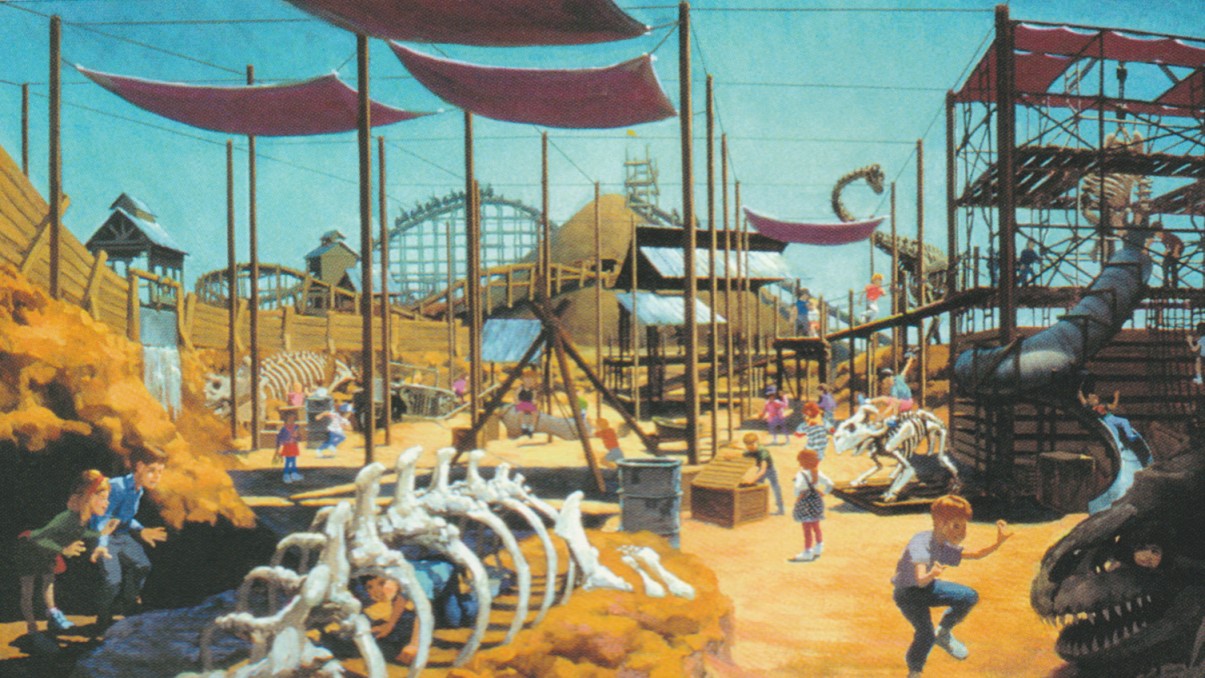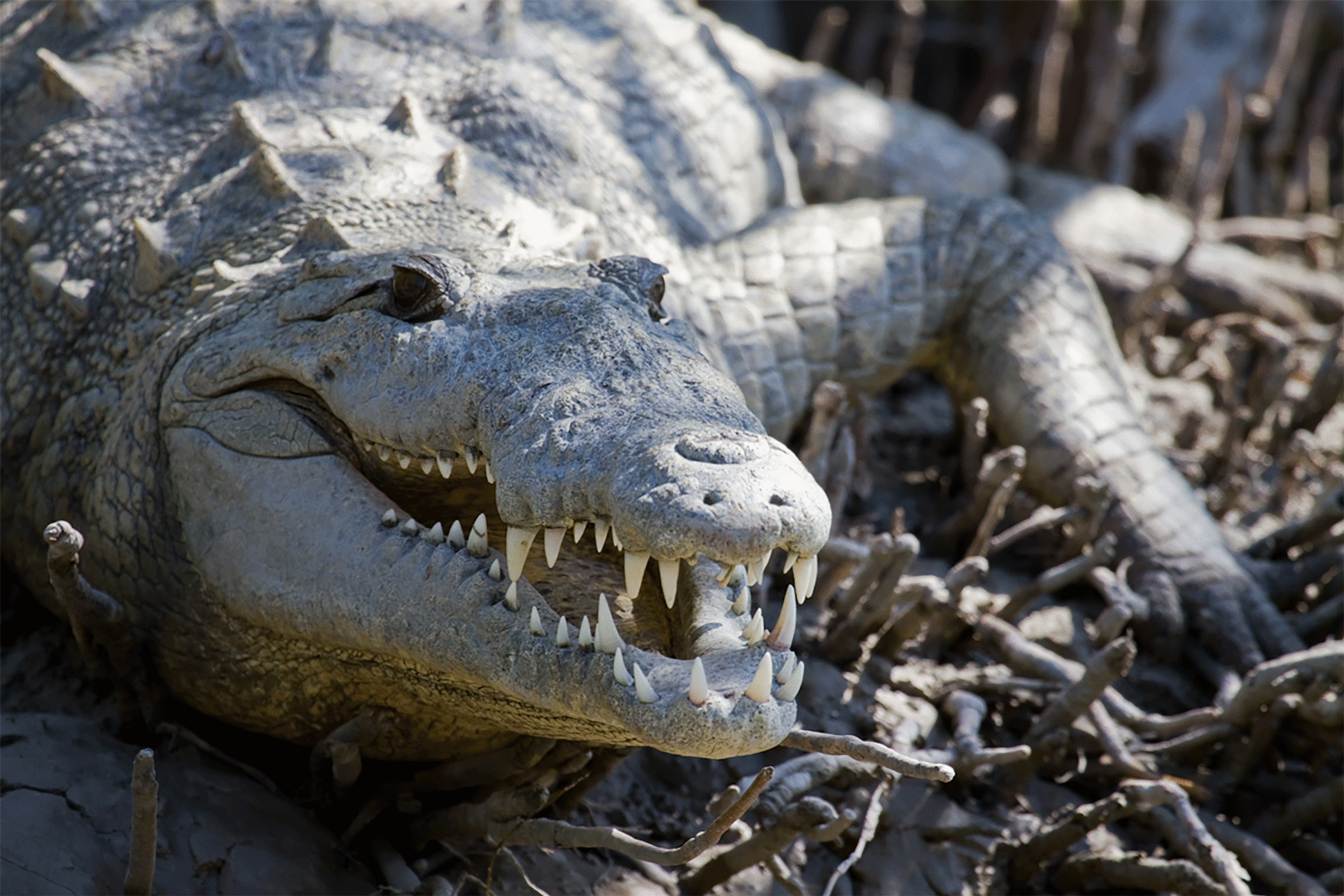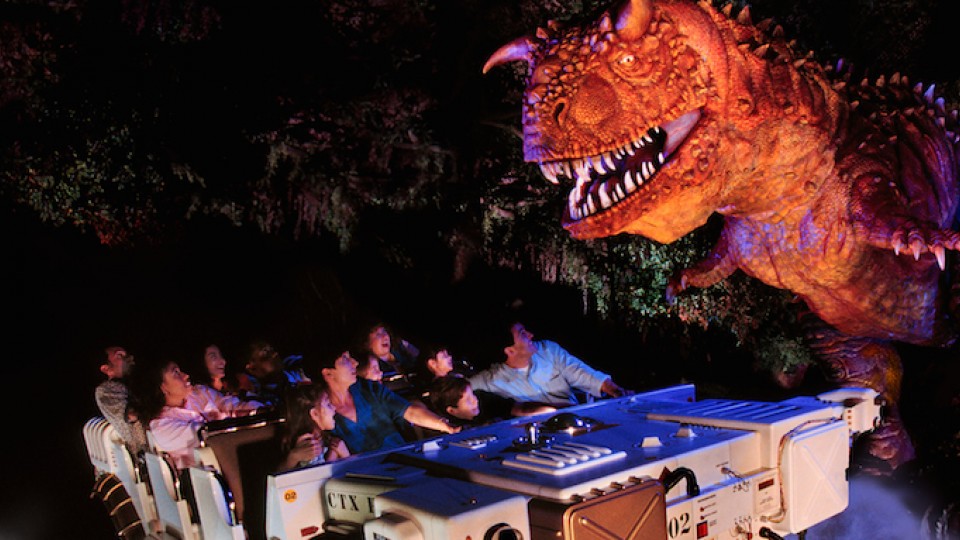Let us continue our journey through Disney's Animal Kingdom...
Discovery Island is the central hub of Disney’s Animal Kingdom, consisting of the island in the center of a vast flowing river, which seems to flow its way throughout the entire park. Bridges connect Discovery Island to the other lands of the park. Discovery Island is filled with vast jungles, flowing rivers, cascading waterfalls, encounters with real-animals and plenty of secrets left to be seen. Discovery Island is a place of excitement and adventure. The island honors the greatness of animals and nature, apparent in the buildings and overall thematic influences seen throughout Discovery Island. While Discovery Island is not meant to depict any sort of actual “place”, its architectural influences come from the equatorial islands from around the world, places like Bali, the Caribbean, the South Seas, Barbados and Jamaica. The artwork of the buildings features ornate animal carvings and sculptures.
The vibe of Discovery Island is one alive with music and fun. Throughout the island are various craftsmen and artists, all of whom use the animal kingdom and nature as inspiration for their work. To help welcome guests to this world of adventure, the Sensational Six – Mickey, Minnie, Donald, Daisy, Goofy and Pluto – can be found roaming throughout Discovery Island, offering photos, autographs and hugs. The Viva Gaia Street Band can be heard throughout the day at their performance space across from Flame Tree Barbecue, lending a tropical flair to the island atmosphere.
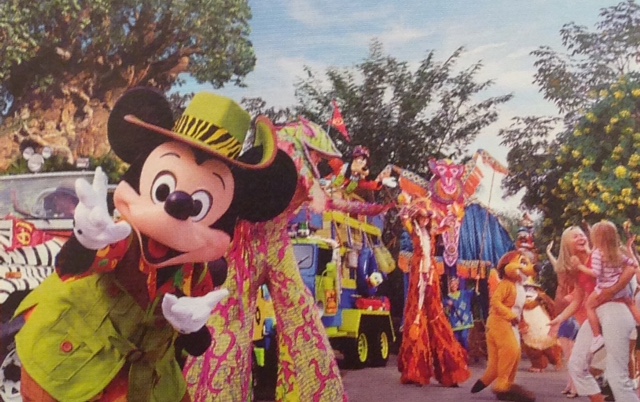
Now, of course, every Disney theme park needs a parade, and Animal Kingdom finds its parade in the form of Mickey’s Jammin’ Jungle Parade. The story behind this procession is that Mickey and the gang have come to town for an expedition, and they have decided to hold a special celebration in tribute to the animals of the Animal Kingdom. The procession weaves around Discovery Island and features unique and artistic depictions of animals. Expect to see stilt-walkers, drummers, giant animal puppets, and of course, your favorite Disney friends. I’ve even heard that Mickey, Minnie and Goofy brought their own jeeps along, and once you look at them, you’ll see they’ve added a bit of personality to them.
Continuing on from the entrance from The Oasis, guests walk along an ornate wooden bridge, crossing over the Discovery River. Here guests are then emptied into the main plaza entryway of Discovery Island. Vast jungles, trees, beautiful flowers and ruins of what may have been a once very active building are scattered throughout the perimeter of the area. Trees and plants are even planted backstage, to make the area of Discovery Island seem more expansive, more immersive, as if a whole world could possibly be explored in this jungle.
Just ahead, planted in the center of the island is the Tree of Life, the icon of Disney’s Animal Kingdom. This centerpiece is one of the most exquisite and elaborate pieces of art that Disney has ever created. It is a piece of art that both captures the beautiful simplicity of nature and the kingdom of wildlife. The Tree of Life itself depicts the Animal Kingdom as it is, featuring 325 animals carved into the wooden tree trunk, even carved into the roots and branched which extend from the tree. It could and will take hours to spot every detail of the tree. The more one looks, the more it seems as though the tree is continuing to grow and branch off with new details!
As I’m sure you’ve noticed, each park in Walt Disney World features its own unique opening ceremony. Here in Disney’s Animal Kingdom, that ceremony is “The Adventure Begins.” Every day, in front of the Tree of Life, a safari truck pulls up carrying Minnie, Goofy and Pluto, making sure they have all they need for a day full of adventure. As for their guide, one Mickey Mouse, he appears via a lift mere inches away from the Tree itself. With the gang all together, there’s only one more thing left to do: start the day with a joyous shout of “Let the adventure begin!”
When continuing down through the main plaza into Discovery Island, directly ahead, guests will find the Tree of Life Garden, a small garden area, surrounded by tall trees and plants. The garden leads into a small enclosed section of Discovery Island, where guests can get a closer look at the front side of the Tree of Life. The garden also offers glimpses of some of the animal inhabitants, such as flamingos, lemurs and kangaroos.
A nearby path leads guests through dense, lush forests, proceeding directly inside the trunk of the mighty tree. From within the mighty tree, we are invited to take a seat and behold the world of animals and their habitats, and what we can do to make sure they last for a long time; behold the wonder of that magnificent planet we call ... Earth.

In a concept devised by @PerGron for his Disney’s Wild Kingdom concept, Earth – or, to use its full name, “Earth: An Environmental Fable” – is a show narrated by an Audio-Animatronics figure of Gaia, otherwise known as “Mother Earth.” She tells stories of different animals, mainly sourced from folklore from around the world, tying the stories into real-life animal facts and how they contribute to the Circle of Life. However, her story is interrupted by her brother, Thanatos, otherwise known as “Death.” Thanatos offers his own perspective on the Circle of Life, claiming that death is not just misery, but rather, the ending of an age, symbolizing new beginnings and the chance for new creatures to take control as the dominant species. Thanatos is angered by how humans destroy the planet’s environment, and more than eager to end humanity’s age as the dominant species. But Gaia is able to quell her brother’s rage by describing how humanity is recognizing the fact that they can destroy the environment, and are taking measures to fix the damage. The show utilizes a film as well as animatronics, relating to a Hall of Presidents or American Adventure more than just a film or just an animatronic show.
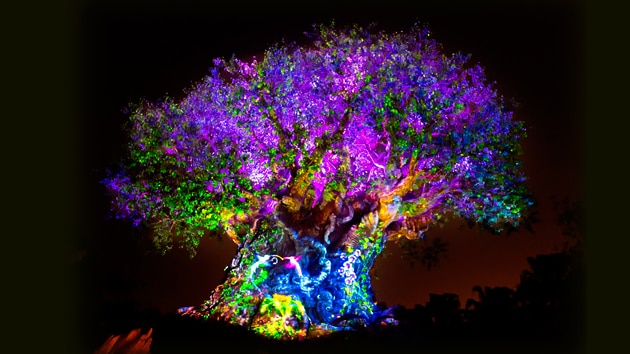
Come nightfall, the mighty tree comes to life with the beauty of Tree of Life: Awakenings. Utilizing astounding projection technology, the spirits of the Animal Kingdom imbibe the Tree with the natural wonders of our Earth. Stories involve hummingbirds, fox and deer, and utilize unique music and artistry to help weave the tale.
Heading back through Discovery Island, towards the entrance to Earth, guests will find the Discovery Island Trails, a trail which snakes its way throughout the base of the Tree of Life. The area is actually very well-hidden and is missed by many people completely, it almost seems as a bit of a “restricted” area, but that is a part of the adventure, right? As guests make their way through the ascending paths leading up the slopes of the island, the lush foliage falls away to reveal breath-taking vistas of the Tree of Life. Ornate animal carvings are featured in the branches entangling throughout the path. Guests proceed underneath a tunnel passage, revealing a waterfall, creating a mist effect throughout the cavern. Continuing down the trail, guests will also find other viewing areas for the animals from the Tree of Life Garden, such as kangaroos, birds and even a pool of swimming fish. The first trail disposes guests into the far-end of Discovery Island, just off of the entrance to Africa. The second trail leads through some pelican and flamingo environments, a cluster of parrots, some porcupine, a tortoise and other animals. The path brings guests right down towards Discovery Lake, leading right to the exit of Earth, at the very base of the Tree of Life, offering more breath-taking vistas of the scenery. It is a beautiful sight to behold.
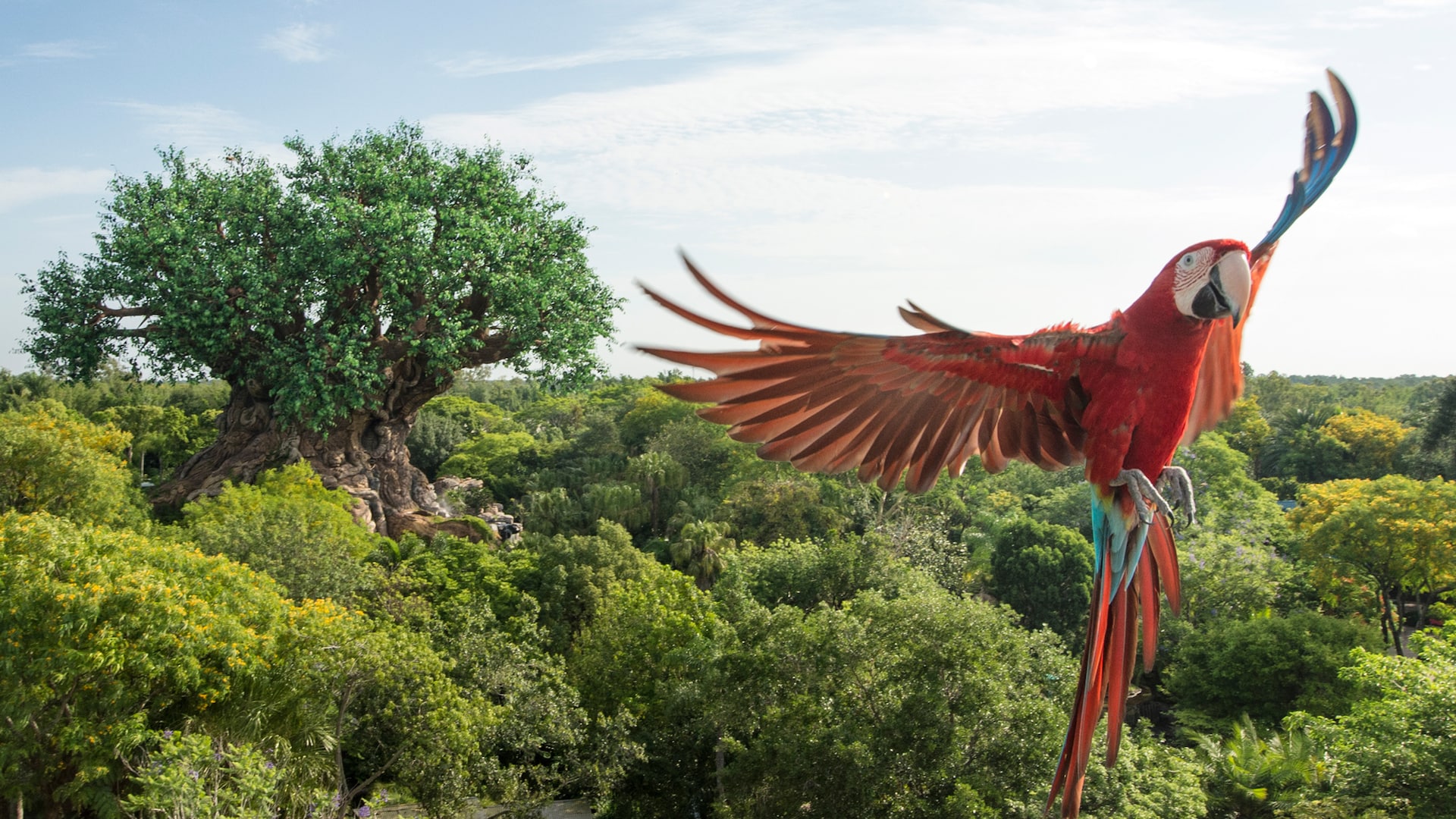
Every day, watch as the skies above the Tree of Life burst with living color during Winged Encounters: The Kingdom Takes Flight, a show featuring macaws. Keep your peepers peeled for all six shades of macaw as they’re showcased in flight—from hyacinth, green-winged and military to blue and gold, blue-throated and scarlet. Each awe-inspiring specimen features a wingspan of up to 60 inches, which you can witness firsthand as they soar up and around the heart of the park.
To the left of the plaza, guests will find the Island Mercantile store, a shop themed to a shipping company, celebrating working animals, such as camels and elephants. This store features Disney character merchandise, Disney’s Animal Kingdom merchandise, clothing and other sorts of paraphernalia. It is one of the main shops of Disney’s Animal Kingdom, offering a wide selection of merchandise to choose from. Lilo and Stitch often meet guests nearby.
Continuing northward, towards Africa, guests will find Pizzafari, a quick-service restaurant specializing in Italian foods and salads. Colorful animal murals decorate the restaurant. The restaurant also includes a small, closed off gazebo area at the back of the restaurant, also open to dine in, which almost appears to be sheltered completely in lush foliage, making it a quiet, relaxing place to take a break in. Located behind Pizzafari is Tiffins. This table-service restaurant celebrates the art of traveling, featuring a diverse menu drawing from places that inspired the creation of Disney’s Animal Kingdom. Open for both lunch and dinner, Tiffins includes waterfront views from comfortable indoor and outdoor seating areas. And if you’re wondering about the name, “tiffin” is an Indian English word for a midday meal or a type of container used to carry food while traveling.
Back at the exit of the Discovery Island Trails, directly ahead, right before the entrance to Africa, guests will come across Creature Comforts, a Starbucks location for the park. On the other side of Discovery Island, across from Island Mercantile, the Disney Outfitters store is located, offering nature-themed gifts and an abundance of clothing. The store also features ornately designed totem poles of animals. In 2015, the Disney Outfitters store expanded into the Riverside Depot. The store carries a variety of character merchandise, and offerings from many of the stores found in the park. The Disney Outfitters and Riverside Depot combination is basically Animal Kingdom’s equivalent of the Magic Kingdom’s Emporium.

Just beyond the store(s), a small rampway leading down to a dock along the Discovery Lake. Here, guests will find the first stop for the Discovery Island Riverboats. These boats serve as the first of two major forms of transportation around this large park. The boats make three stops along their trek down the Discovery River: at Discovery Island, at Africa and at Asia.
Just across from the Riverboat Landing, guests will find the Flame Tree Barbecue, which serves up a selection of barbecued entrees, all wood-roasted to perfection. The seating location is also located right along the Discovery Lake, looking upon Expedition Everest. The seating area is a beautiful Balinese water garden and offers one of the most tranquil spots to enjoy a meal in the park. Guests can dine under ornately carved gazebos, overlooking the river. The entrance to Earth can be found right nearby, situated next door to the access point to the park-wide Wilderness Explorers game, inspired by the Pixar film Up. Along the path leading to Asia is Beastly Bazaar, a shop themed around water animals offering tropical wares, like surfwear and island-inspired merch.
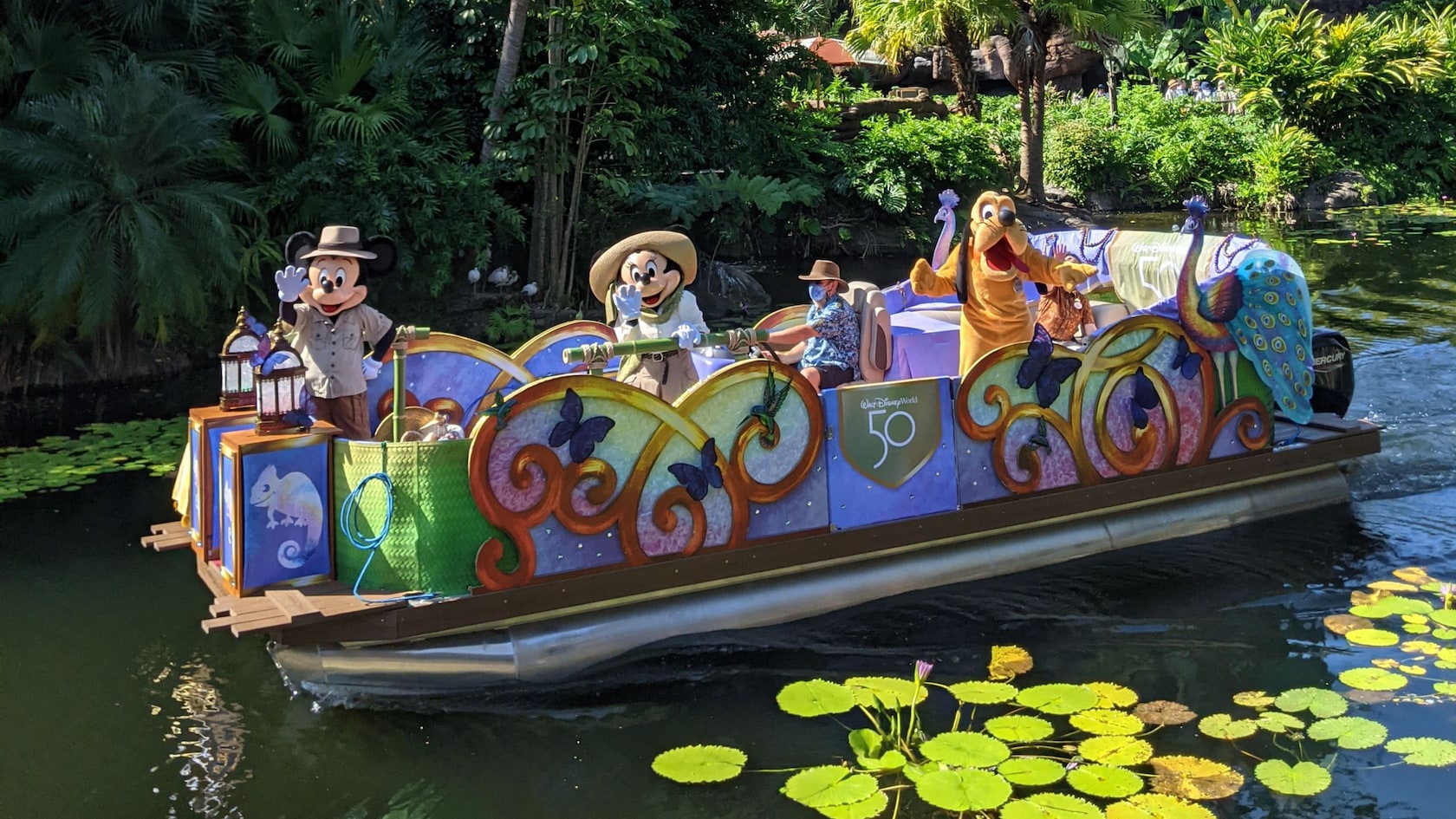
Along Discovery Lake are another form of processional here at the parks: “Flotillas.” Like the cavalcades of the Magic Kingdom, these flotillas allow guests to see the characters in procession without having to scout out a spot on the parade route. There are five flotillas that sail out daily: one featuring Mickey, Minnie and Pluto; one featuring Donald, Daisy and Launchpad McQuack; one featuring Goofy, Chip and Dale; one featuring either Rafiki and Timon or Baloo and King Louie; and one featuring an enthusiastic troupe of drummers.
~ ~ ~ ~ ~
That, my friends, was the central hub of Disney's Animal Kingdom. Join me again on Saturday, January 7, when we'll explore the first distinct area of the park. An area that many have dreamed of seeing actually come to fruition. An area that never came to be in our real-life WDW...but in this Mirror WDW, it absolutely did.
~ ~ ~ ~ ~
Discovery Island

Discovery Island

Discovery Island is the central hub of Disney’s Animal Kingdom, consisting of the island in the center of a vast flowing river, which seems to flow its way throughout the entire park. Bridges connect Discovery Island to the other lands of the park. Discovery Island is filled with vast jungles, flowing rivers, cascading waterfalls, encounters with real-animals and plenty of secrets left to be seen. Discovery Island is a place of excitement and adventure. The island honors the greatness of animals and nature, apparent in the buildings and overall thematic influences seen throughout Discovery Island. While Discovery Island is not meant to depict any sort of actual “place”, its architectural influences come from the equatorial islands from around the world, places like Bali, the Caribbean, the South Seas, Barbados and Jamaica. The artwork of the buildings features ornate animal carvings and sculptures.
The vibe of Discovery Island is one alive with music and fun. Throughout the island are various craftsmen and artists, all of whom use the animal kingdom and nature as inspiration for their work. To help welcome guests to this world of adventure, the Sensational Six – Mickey, Minnie, Donald, Daisy, Goofy and Pluto – can be found roaming throughout Discovery Island, offering photos, autographs and hugs. The Viva Gaia Street Band can be heard throughout the day at their performance space across from Flame Tree Barbecue, lending a tropical flair to the island atmosphere.

Now, of course, every Disney theme park needs a parade, and Animal Kingdom finds its parade in the form of Mickey’s Jammin’ Jungle Parade. The story behind this procession is that Mickey and the gang have come to town for an expedition, and they have decided to hold a special celebration in tribute to the animals of the Animal Kingdom. The procession weaves around Discovery Island and features unique and artistic depictions of animals. Expect to see stilt-walkers, drummers, giant animal puppets, and of course, your favorite Disney friends. I’ve even heard that Mickey, Minnie and Goofy brought their own jeeps along, and once you look at them, you’ll see they’ve added a bit of personality to them.
Continuing on from the entrance from The Oasis, guests walk along an ornate wooden bridge, crossing over the Discovery River. Here guests are then emptied into the main plaza entryway of Discovery Island. Vast jungles, trees, beautiful flowers and ruins of what may have been a once very active building are scattered throughout the perimeter of the area. Trees and plants are even planted backstage, to make the area of Discovery Island seem more expansive, more immersive, as if a whole world could possibly be explored in this jungle.
Just ahead, planted in the center of the island is the Tree of Life, the icon of Disney’s Animal Kingdom. This centerpiece is one of the most exquisite and elaborate pieces of art that Disney has ever created. It is a piece of art that both captures the beautiful simplicity of nature and the kingdom of wildlife. The Tree of Life itself depicts the Animal Kingdom as it is, featuring 325 animals carved into the wooden tree trunk, even carved into the roots and branched which extend from the tree. It could and will take hours to spot every detail of the tree. The more one looks, the more it seems as though the tree is continuing to grow and branch off with new details!
As I’m sure you’ve noticed, each park in Walt Disney World features its own unique opening ceremony. Here in Disney’s Animal Kingdom, that ceremony is “The Adventure Begins.” Every day, in front of the Tree of Life, a safari truck pulls up carrying Minnie, Goofy and Pluto, making sure they have all they need for a day full of adventure. As for their guide, one Mickey Mouse, he appears via a lift mere inches away from the Tree itself. With the gang all together, there’s only one more thing left to do: start the day with a joyous shout of “Let the adventure begin!”
When continuing down through the main plaza into Discovery Island, directly ahead, guests will find the Tree of Life Garden, a small garden area, surrounded by tall trees and plants. The garden leads into a small enclosed section of Discovery Island, where guests can get a closer look at the front side of the Tree of Life. The garden also offers glimpses of some of the animal inhabitants, such as flamingos, lemurs and kangaroos.
A nearby path leads guests through dense, lush forests, proceeding directly inside the trunk of the mighty tree. From within the mighty tree, we are invited to take a seat and behold the world of animals and their habitats, and what we can do to make sure they last for a long time; behold the wonder of that magnificent planet we call ... Earth.

In a concept devised by @PerGron for his Disney’s Wild Kingdom concept, Earth – or, to use its full name, “Earth: An Environmental Fable” – is a show narrated by an Audio-Animatronics figure of Gaia, otherwise known as “Mother Earth.” She tells stories of different animals, mainly sourced from folklore from around the world, tying the stories into real-life animal facts and how they contribute to the Circle of Life. However, her story is interrupted by her brother, Thanatos, otherwise known as “Death.” Thanatos offers his own perspective on the Circle of Life, claiming that death is not just misery, but rather, the ending of an age, symbolizing new beginnings and the chance for new creatures to take control as the dominant species. Thanatos is angered by how humans destroy the planet’s environment, and more than eager to end humanity’s age as the dominant species. But Gaia is able to quell her brother’s rage by describing how humanity is recognizing the fact that they can destroy the environment, and are taking measures to fix the damage. The show utilizes a film as well as animatronics, relating to a Hall of Presidents or American Adventure more than just a film or just an animatronic show.

Come nightfall, the mighty tree comes to life with the beauty of Tree of Life: Awakenings. Utilizing astounding projection technology, the spirits of the Animal Kingdom imbibe the Tree with the natural wonders of our Earth. Stories involve hummingbirds, fox and deer, and utilize unique music and artistry to help weave the tale.
Heading back through Discovery Island, towards the entrance to Earth, guests will find the Discovery Island Trails, a trail which snakes its way throughout the base of the Tree of Life. The area is actually very well-hidden and is missed by many people completely, it almost seems as a bit of a “restricted” area, but that is a part of the adventure, right? As guests make their way through the ascending paths leading up the slopes of the island, the lush foliage falls away to reveal breath-taking vistas of the Tree of Life. Ornate animal carvings are featured in the branches entangling throughout the path. Guests proceed underneath a tunnel passage, revealing a waterfall, creating a mist effect throughout the cavern. Continuing down the trail, guests will also find other viewing areas for the animals from the Tree of Life Garden, such as kangaroos, birds and even a pool of swimming fish. The first trail disposes guests into the far-end of Discovery Island, just off of the entrance to Africa. The second trail leads through some pelican and flamingo environments, a cluster of parrots, some porcupine, a tortoise and other animals. The path brings guests right down towards Discovery Lake, leading right to the exit of Earth, at the very base of the Tree of Life, offering more breath-taking vistas of the scenery. It is a beautiful sight to behold.

Every day, watch as the skies above the Tree of Life burst with living color during Winged Encounters: The Kingdom Takes Flight, a show featuring macaws. Keep your peepers peeled for all six shades of macaw as they’re showcased in flight—from hyacinth, green-winged and military to blue and gold, blue-throated and scarlet. Each awe-inspiring specimen features a wingspan of up to 60 inches, which you can witness firsthand as they soar up and around the heart of the park.
To the left of the plaza, guests will find the Island Mercantile store, a shop themed to a shipping company, celebrating working animals, such as camels and elephants. This store features Disney character merchandise, Disney’s Animal Kingdom merchandise, clothing and other sorts of paraphernalia. It is one of the main shops of Disney’s Animal Kingdom, offering a wide selection of merchandise to choose from. Lilo and Stitch often meet guests nearby.
Continuing northward, towards Africa, guests will find Pizzafari, a quick-service restaurant specializing in Italian foods and salads. Colorful animal murals decorate the restaurant. The restaurant also includes a small, closed off gazebo area at the back of the restaurant, also open to dine in, which almost appears to be sheltered completely in lush foliage, making it a quiet, relaxing place to take a break in. Located behind Pizzafari is Tiffins. This table-service restaurant celebrates the art of traveling, featuring a diverse menu drawing from places that inspired the creation of Disney’s Animal Kingdom. Open for both lunch and dinner, Tiffins includes waterfront views from comfortable indoor and outdoor seating areas. And if you’re wondering about the name, “tiffin” is an Indian English word for a midday meal or a type of container used to carry food while traveling.
Back at the exit of the Discovery Island Trails, directly ahead, right before the entrance to Africa, guests will come across Creature Comforts, a Starbucks location for the park. On the other side of Discovery Island, across from Island Mercantile, the Disney Outfitters store is located, offering nature-themed gifts and an abundance of clothing. The store also features ornately designed totem poles of animals. In 2015, the Disney Outfitters store expanded into the Riverside Depot. The store carries a variety of character merchandise, and offerings from many of the stores found in the park. The Disney Outfitters and Riverside Depot combination is basically Animal Kingdom’s equivalent of the Magic Kingdom’s Emporium.

Just beyond the store(s), a small rampway leading down to a dock along the Discovery Lake. Here, guests will find the first stop for the Discovery Island Riverboats. These boats serve as the first of two major forms of transportation around this large park. The boats make three stops along their trek down the Discovery River: at Discovery Island, at Africa and at Asia.
Just across from the Riverboat Landing, guests will find the Flame Tree Barbecue, which serves up a selection of barbecued entrees, all wood-roasted to perfection. The seating location is also located right along the Discovery Lake, looking upon Expedition Everest. The seating area is a beautiful Balinese water garden and offers one of the most tranquil spots to enjoy a meal in the park. Guests can dine under ornately carved gazebos, overlooking the river. The entrance to Earth can be found right nearby, situated next door to the access point to the park-wide Wilderness Explorers game, inspired by the Pixar film Up. Along the path leading to Asia is Beastly Bazaar, a shop themed around water animals offering tropical wares, like surfwear and island-inspired merch.

Along Discovery Lake are another form of processional here at the parks: “Flotillas.” Like the cavalcades of the Magic Kingdom, these flotillas allow guests to see the characters in procession without having to scout out a spot on the parade route. There are five flotillas that sail out daily: one featuring Mickey, Minnie and Pluto; one featuring Donald, Daisy and Launchpad McQuack; one featuring Goofy, Chip and Dale; one featuring either Rafiki and Timon or Baloo and King Louie; and one featuring an enthusiastic troupe of drummers.
~ ~ ~ ~ ~

